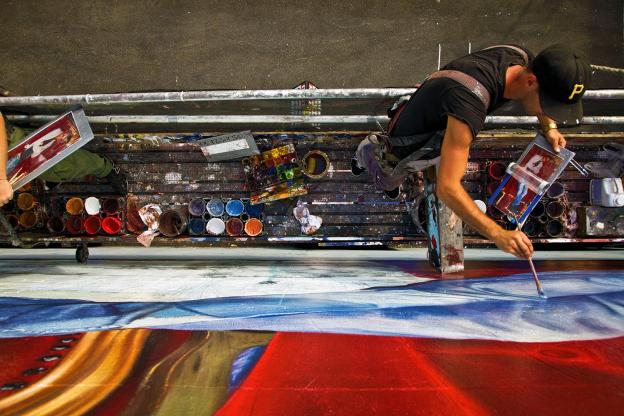 As recently as the 1980s, when someone needed a storefront, mural, banner, billboard, or street sign, the first person he would call was a sign painter, a skilled tradesman who would do the work by hand, with a brush and paint.
As recently as the 1980s, when someone needed a storefront, mural, banner, billboard, or street sign, the first person he would call was a sign painter, a skilled tradesman who would do the work by hand, with a brush and paint.
But the advent of technology dealt the first major blow to sign painting as a profession when die-cut vinyl lettering plotters were introduced, offering business owners a cheaper and quicker method of getting words on wall or window. Then inkjet printing and digital-design options followed with what was nearly a coup de grâce to the craft.
Faythe Levine, the co-director of a new documentary called Sign Painters, is doing her best to make the argument that the “progress” made in technology hasn’t necessarily been for the best when it comes to getting a good sign made.
“Within the past 30 years, the concept of a sign painter has drastically changed with the influence of modern technology, and there isn’t the connection with a person’s skill and trade with the actual sign,” Levine said. “Co-director Sam Macon and I] would argue that the progression of technology doesn’t necessarily translate to advancements or improvements in design. You can create a good-looking, well-designed sign with hand paint or digital influences, but what traditional sign painting enforces is a base knowledge in design and layout.”
As antiquated as the art may sound to some in today’s day and age, if Sign Painters is any indication, the craft remains alive and well in a small contingent of painters who remain true to their calling. While some are bitter – resigned to defeat at the hands of technology – many are pressing on in an attempt to remind everyone that what they bring to the table is much more than just words on a wall.

“We were both pretty shocked with how many working sign painters were still out [there],” Levine said. “And then once we began talking with more of the old-school painters and realized how much influence sign painting has had on branding, advertising, and so many things we interact with on a daily basis, it really blew our minds.”
Levine said a goal in making the film is to help educate the general public about the sign-painting tradition in the United States and hopefully instill a respect in audiences for an industry she still considers a “relevant, available” alternative to new methods, rather than simply create “an old-timey-looking film about a dying trade.” The film is a follow-up to a companion book of the same title Levine and Macon had written, released last year.
But rather than waging a war on the digital age, Levine said she recognizes that there is room for both crafts to co-exist and maybe even better each other.
“Our movie is the perfect example of this,” she said. “We wanted the titles to be hand-lettered, but we obviously then needed to scan them in for post-production purposes.”

It was a handcrafted touch to a film that was otherwise created digitally – on Canon DSLR cameras, as well as a Sony PMW-F3 camcorder – out of necessity for Levine and her cohorts as independent filmmakers. She noted that many of the painters she met in filming the documentary even use computers as another tool in their shops. But at its core, the film wants us to know that the sign painters’ experience and hand-drawn methods still have lessons to impart on the digital age.
“We want people to think about how things look, how they got there, and who may be responsible for these types of things – both good and bad,” Levine said. “Having an education about hands-on trades and art forms is a part of this process. It’s terrifying when you think about the fact that people don’t even know how to hold a pencil correctly anymore. Let’s not forget how to use our hands.”
(Images and video © SIGN PAINTERS a documentary by Faythe Levine & Sam Macon. All Rights Reserved.)





